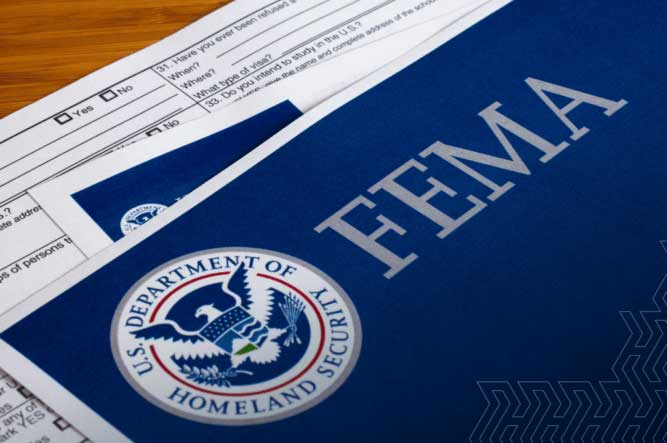Emergency Freight: Understanding FEMA Loads for Truckers

What are you waiting for?
Make more money starting now.
If you are hauling for the Federal Emergency Management Agency (FEMA) or planning to do so, it’s critical to understand the significance of these loads and the role of truckers in transporting them. In a time when people are leaving an area ahead of or as a result of natural disasters like earthquakes, hurricanes, or tornadoes, truckers are tasked with moving essential relief supplies to these areas swiftly.
While many truckers feel called to help in these situations, disaster relief efforts present different circumstances and expectations for drivers. We have compiled a guide to help you better understand what you can expect when hauling FEMA truck loads and how to find FEMA loads.
What are FEMA loads?
A FEMA load is cargo containing essential supplies delivered to regions predicted or already experiencing natural disasters. FEMA plays a critical role in disaster relief, and truck drivers are vital to this mission. They transport FEMA loads with essentials like food, water, medical equipment, and construction materials — directly to disaster zones.
The timely delivery of FEMA loads ensures communities have the support they need to recover and build. This makes truckers key players in the nation’s disaster response efforts.
Note about FEMA in 2025
Early in 2025, President Donald Trump proposed shifting disaster response responsibility from the federal to the state level. While no formal changes have been made so far, it’s worth keeping an eye on.
Types of FEMA loads
There are different types of FEMA loads for truck drivers, including:
- Search and rescue equipment: Often the first loads sent in, search and rescue items help trained professionals assist as many people as possible — quickly. Communication equipment is also vital, and these items allow first responders to continue their efforts efficiently. Communication devices also let people notify loved ones of their whereabouts to get help faster.
- Emergency food and drinking water: This includes food with a long shelf life, such as canned goods, dry mixes, and other staple items that feed families. Additionally, water systems are often down for days or even weeks after a disaster. Having clean drinking water is essential, and FEMA loads can include drinking water and water purification systems.
- Medical equipment and supplies: Hospitals are frequently damaged or overloaded with patients during a natural disaster. Getting medicine and medical supplies delivered can be critical.
- Construction materials and power: To facilitate rapid repair and restoration efforts, construction materials like lumber and supplies are needed. Additionally, when power systems are damaged and unavailable, generators help restore an area. Fuel is also necessary to power trucks and other equipment in an area.
- Disaster cleanup supplies: The amount of debris is often staggering after a natural disaster, and having proper tools to clean up helps everyone involved.
- Clothing and personal care items: People often can’t access their personal belongings during a natural disaster. Clothing and personal care items can help until they can return home.

How much do FEMA loads pay?
In general, average carrier rates range from $1.50 to $2.50 per mile but can go higher, especially for emergency freight. However, it’s important to note that FEMA uses scheduled equipment rates that change annually. Rates also fluctuate based on market conditions. During high demand, like after a major disaster, competition among drivers for FEMA contracts can drive up wages.
The nature of the load also plays a part in pay. For instance, specialized loads like hazardous materials and medical supplies could result in higher compensation. Additionally, if the load must be delivered under tight deadlines, you might receive premium rates for these expedited services.
On the Truckstop Load Board, you can search keywords like “FEMA loads,” “emergency freight,” or specific locations affected by disasters. You can also filter by load type, destination, and origin to find loads and their rates. You can compare rates for different FEMA loads to find average rates for various load types and get market rate insights and historical data so that you can understand payment trends for FEMA loads.
The challenges of hauling FEMA loads
Hauling FEMA loads is different from any load you might haul on a regular basis. They come with their own challenges, and it’s important to be prepared. Here are some you might face when hauling a FEMA load:
- Unpredictable schedules: Disaster brings unpredictability. Be flexible and prepared to help in different capacities.
- Potential safety risks: Entering a natural disaster area can present unsafe roads, infrastructure, or weather conditions. Come prepared with necessities in case you are confined to your truck, and prepare to take care of yourself as much as possible.
- Long waiting times at loading and unloading sites: It’s important to be patient while relief coordinators are working to plan the best way to assist those affected. Expect some disorganization due to unforeseen circumstances, and be accommodating to changes or long wait times.
- Stringent government regulations: Hauling for FEMA means you are hauling for the government. With this comes additional regulations and paperwork.
- Need for specialized procedures: Because of the damage done to the area, it’s likely specialized equipment or handling procedures will be required. Be patient and open to asking for help if you need it.
- Stress and emotional toll: You will likely see extreme situations that can take a toll on your mental health. Remember why you are there, and take time to decompress when you can.
- Communication difficulties: When cell phone towers are down and power lines are likely to be disrupted, having a backup plan, such as written directions and contact information on paper, is essential.
Ways you can prepare to help
Generally, if you’ve committed to hauling FEMA loads, there are steps you can take to prepare yourself and your vehicle:
- Regularly inspect your vehicle: Maintain and inspect your vehicle and your equipment so you don’t encounter your own unexpected disasters.
- Use GPS and keep updated maps: Apps on your phone can be unreliable if communication systems and cell towers are down. Make sure you have truck routing software or an updated atlas in case of emergency.
- Keep emergency and survival equipment: Check your vehicle for everything you need in case you find yourself living in your truck for a few days.
- Comply with government regulations: With government contracts come more specific guidelines. Be sure you understand all government regulations before you begin your journey.
- Stay informed about weather conditions: Be prepared to drive in extreme weather. Check the forecast regularly for changing conditions and potential hazards.
- Keep communication lines open: Dispatchers are your friends, so be sure to check in with them regularly.
- Practice patience and stress skills: Be prepared for chaos at staging areas. You will be dealing with government officials who are managing constant change and working tirelessly to keep systems moving. Instructions may change often.
- Get plenty of rest on the road: Take care of yourself. You might be tempted to work more than you should and jump in to help with disaster relief, but remember that a drowsy driver is an unsafe driver.
- Keep paperwork available: Keep your paperwork where you can get to it easily and in a waterproof bag. This should include compliance documents like proof of insurance, FEMA eligibility, operating authority, commercial driver’s license, and truck and trailer registration.
- Take disaster response training: Being prepared personally for what to do in case of a disaster is important for your confidence when hauling a FEMA load. It can also keep you and those around you safe.
Preparation checklist for FEMA truckers
In summary, follow this preparation checklist if you’re a FEMA truck driver:
- Conduct regular vehicle maintenance and inspections.
- Get a reliable GPS and updated paper maps.
- Put together an emergency survival kit.
- Comply with government regulations.
- Check weather monitoring tools.
- Communicate with dispatchers.
- Gather compliance paperwork.
How to become a FEMA-approved driver
To be approved to haul FEMA loads, you must go through an application process and stay compliant with all regulations. Here’s a step-by-step guide to help you get started.
1. Research FEMA’s guidelines
Familiarize yourself with FEMA documentation, including policies and procedures. Read FEMA’s Instructions for All Potential Transportation Service Providers. This includes important dates like application registration deadlines. These guides can help you avoid pitfalls and ensure a smoother application process.
2. Read FEMA guides
You’ll need to read three different guides before getting approval to become a FEMA truck driver:
- FEMA Standard Tender of Service
- FEMA Uniform Rules Tariff
- U.S. Government Freight Transportation Handbook
Each guide contains important information about your operational requirements. It also includes payment terms and compliance expectations.

3. Register on SAM.gov
Visit SAM.gov to be sure your registration is approved, current, and active. This is necessary for government contracts. Checking regularly will help you avoid lapses that could impact your ability to haul FEMA freight.
4. Prepare your compliance documents
Gather all necessary compliance documents. These include proof of insurance, operating authority, and other FEMA paperwork, as well as certifications related to safety standards. You should also have documents showing previous experience hauling emergency freight. Having these items ready to go can speed up the approval process.
5. Fill out the TSP registration form
Complete the Transportation Service Providers (TSP) registration form and request an account with Logistics Supply Chain Management System Cloud. Follow the guidelines closely, making sure all information is accurate and complete. This will help ensure errors or omissions do not delay your approval.
6. Check your email for approval
Monitor your email for confirmation of your application status. FEMA will notify you once your application has been processed. You’ll want to be vigilant since they might have follow-up questions or request additional information from you.
7. Follow the Standard Tender of Service (STOS) program
Once you’re approved, follow the Standard Tender of Service program. Adhere to these guidelines, as they’ll govern how you operate as a FEMA-approved driver. Complying with STOS ensures you can do future loads. It also helps you keep a positive working relationship with FEMA and any stakeholders in disaster relief.
How to find FEMA truck loads
If you’re ready to haul a FEMA load, here are some ways you can find them:
- Use load boards for FEMA loads like Truckstop emergency freight loads — read the load notes and confirm with a broker for details.
- Network with other truckers who have experience hauling FEMA loads to find more.
- Keep up with FEMA announcements and disaster relief efforts.
- Attend industry events and forums where FEMA contracts are often discussed.
- Build a strong relationship with FEMA-approved brokers.
- Regularly check FEMA’s official website for load opportunities.
- Follow social media accounts and blogs related to trucking and FEMA loads.
- Collaborate with transportation companies already involved with FEMA operations.
- Maintain a good reputation and high service levels for potential direct contracts with FEMA.
- Comply with all trucking regulations and keep your driving record clean.
Truckers are essential for emergency freight
Trucking is vital for disaster relief in the United States. Without enough drivers, delivering essential goods to disaster-affected areas becomes impossible. No matter what the natural disaster is, the trucking industry finds solutions to keep the country’s supply chain moving. It ensures delivery of emergency freight where it’s needed most.

Mobilize your operations with Truckstop Go™
To get all the load board information you need in the palm of your hands, download Truckstop Go. You can find high-paying loads, negotiate the best rates, and keep your truck moving. With its user-friendly interface, you can search for FEMA loads and emergency freight effortlessly. This makes it easy to secure timely deliveries in critical situations and to help impacted communities.
Get real-time notifications on new loads and market trends so that you never miss an opportunity. The app also gives you access to essential tools like route planning and expense tracking. Manage your operations more efficiently, connect with other truckers and brokers, and build relationships that lead to consistent work.
Don’t let opportunities pass you by. Request a demo to see our products in action, or download Truckstop Go today to take your trucking business to the next level!
Get helpful content delivered to your inbox.
Sign up today.
Find high-quality loads fast, get higher rates on every haul, and access tools that make your job easier at every turn.






